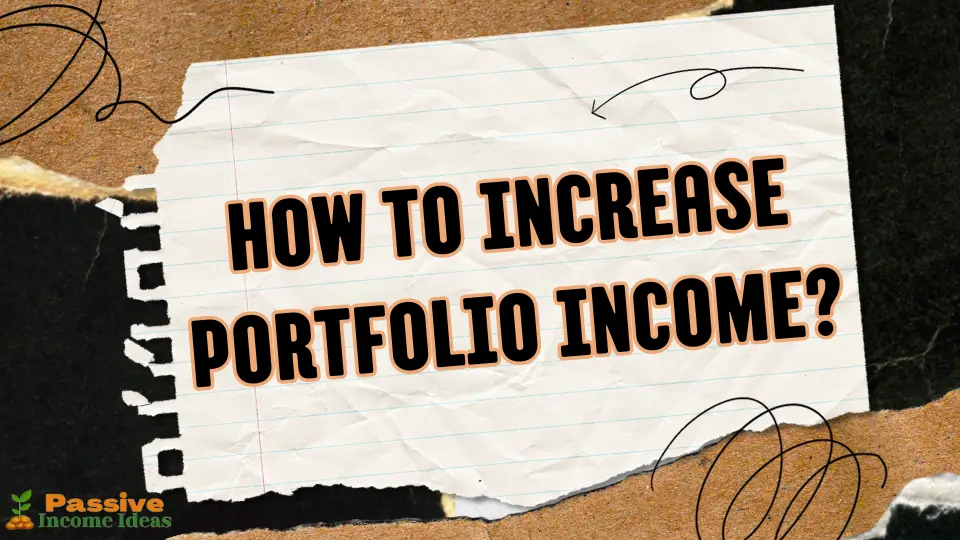Welcome to the world of wealth-building strategies! In the financial landscape, two key players take center stage: Portfolio Income and Passive Income.

Imagine your money working tirelessly to bring in profits while you kick back and enjoy life. That’s the dream, right? In this exploration, we’ll unravel the mysteries behind Portfolio Income and compare it with the ever-popular Passive Income.
Picture your investments as superheroes, each with a unique power – some generating steady streams of cash, while others work quietly in the background.
Portfolio Income involves the earnings from your investments, like stocks and bonds, while Passive Income includes money earned with minimal effort, such as rental income or dividends.
Think of it as a financial face-off, where these two heavyweights compete for the title of ultimate wealth generator.
Get ready for an insightful journey as we decode the secrets of Portfolio Income and draw comparisons with the allure of Passive Income. It’s time to empower your financial knowledge and set the stage for a prosperous future!
What is Portfolio Income?
There are three main types of income:
- Earned Income: This is the money you get for working, like your salary, wages, bonuses, and tips.
- Passive Income: This is like “unearned” money and can come from different places. For example, you might get it from royalties for your creative work, rent payments if you own property, or through things like affiliate marketing. It also includes income from being part of a limited partnership where you own a share of a business but don’t actively run it.
- Portfolio income:- It refers to earnings generated from various financial investments, such as stocks, bonds, and mutual funds. In simple terms, it’s the money you make from owning a mix of different assets. This type of income is distinct from earned income through work or business activities. The portfolio income definition encompasses dividends, interest, and capital gains, which are the key sources contributing to this financial stream. Dividends are periodic payouts from stocks, interest is earned from bonds or savings accounts, and capital gains result from selling investments at a profit.
People often build a diversified portfolio to enhance their chances of earning steady income and potential growth, making portfolio income an integral aspect of overall financial planning.
Portfolio Income vs Passive Income
Understanding the difference between Portfolio Income and Passive Income is like unlocking the secrets of money. Portfolio Income needs you to manage investments actively, while Passive Income lets your money work with less effort from you.
Knowing these distinctions helps in smart money decisions! Here are some key differences between these two income streams…
| Key Points | Portfolio Income | Passive Income |
| 1. Source of Income: | It is generated from various financial investments like stocks, bonds, and mutual funds. | Passive Income earned with minimal effort or active involvement, often from rental properties, dividends, or royalties. |
| 2. Active Participation: | It requires ongoing management and decision making regarding investments. | It involves less active engagement, allowing for a more hands-off approach. |
| 3. Risk and Return: | It is associated with market fluctuations; potential for both gains and losses. | It is generally more stable, with less exposure to market volatility. |
| 4. Time Commitment: | It may demand regular monitoring and adjustments to the investment portfolio. | It often requires initial setup and occasional oversight but less continuous time commitment. |
| 5. Examples: | Portfolio Income Examples are dividends, interest, capital gains from investments. | Passive Income includes Rental income, dividends, affiliate marketing, royalties |
| 6. Diversification: | It involves spreading investments across various assets for risk management. | Passive Income can be diversified across multiple streams for stability. |
| 7. Tax Implications: | It is taxed differently based on investment type and holding period. | It’s tax treatment varies but may benefit from certain tax advantages. |
| 8. Initial Effort: | This requires initial research, decision-making, and capital investment. | It often involves upfront effort in setting up income streams. |
| 9.Long-Term Growth: | Potential for capital appreciation and long-term growth. | It can provide a steady stream of income over the long term. |
| 10. Flexibility: | It allows for active adjustments based on market conditions and financial goals. | It offers flexibility with potential for income generation without continuous active involvement. |
How Is Portfolio Income Created?

Portfolio income is created through wise investments: dividend-paying stocks, dividend and bond funds, capital gains from selling at a profit, and rental income from real estate or Real Estate Investment Trusts (REITs).
To create portfolio income, you have a few options:
Dividend-Paying Stocks:
Buy stocks from companies that pay dividends (regular payouts to shareholders). You can use the received dividends for expenses or, if the company allows, reinvest them to get more shares through a plan called Dividend Reinvestment (DRIP). Be aware of risks, such as the stock price dropping or the company reducing dividends.
Dividend Funds:
Invest in dividend exchange-traded funds (ETFs) or mutual funds. These are pooled investments holding various securities like stocks and bonds. Some are actively managed, while others track specific indexes like the S&P 500. Look into Money Market Mutual Funds for short-term investments.
Bond Funds:
Consider bond funds focusing on specific types of bonds or indexes. Bonds are debt securities issued by companies or governments. Their value can change based on interest rates. Treasurys have low risk, while corporate bonds’ risk is rated by agencies. Bond funds provide income through regular interest payments.
Capital Gains:
Create income through capital gains by selling an investment for a profit. For example, if you bought stocks at $30 per share and sold them later for $50 per share, your capital gains would be the profit of $2,000.
Real Estate or REITs:
Invest in residential or commercial real estate for rental income. However, consider costs like maintenance and property taxes. For a more liquid option, invest in Real Estate Investment Trusts (REITs). These trade like stocks, holding properties or mortgages and paying out dividends, providing diversification for your income portfolio.
How To Increase Portfolio Income?

Increasing portfolio income can involve writing call options on shares in your portfolio. A call option is essentially a deal between the seller (you) and a buyer.
It grants the buyer the right, but not the obligation, to buy a specific number of shares of a stock at an agreed-upon price until a specified future date.
This strategy allows you to potentially earn income by selling the option, offering the buyer the opportunity to purchase shares at a predetermined price if they choose to exercise the option.
For Example:-
Let’s consider an investor who owns 50 shares of XYZ Corporation in their investment portfolio. Currently, XYZ is trading at $50.00 per share. The investor decides to create a call option for those 50 shares at $55.00 (the option’s strike price) and sells the call option for $3.00 per share. This results in a total income of $150 (50 shares x $3.00 a share = $150), known as the option premium.
Upon the option expiration date, if XYZ is trading below $55.00, the option buyer may choose not to exercise the option, allowing the owner of the shares to keep the $150 option premium.
However, if XYZ is trading above the strike price, the option buyer is likely to exercise the option, and the owner of the shares becomes obligated to sell them at the agreed-upon strike price. Alongside potential capital gains, the portfolio owner retains the earned option premium.
Conclusion:-
In conclusion, understanding the nuances of portfolio income and comparing it with passive income is essential for anyone looking to build wealth.
We’ve explored what portfolio income is and delved into various sources, such as dividend-paying stocks, dividend funds, bond funds, capital gains, and real estate or REITs.
Learning how to increase portfolio income is crucial for maximizing returns. While portfolio income shares similarities with passive income, it’s important to note that it may involve more active management.
Additionally, being aware of the taxation aspects of portfolio income is crucial for making informed financial decisions. By decoding portfolio income, individuals can make strategic choices to enhance their financial well-being.
I hope you really liked the info I shared! If you want more or have questions, just let me know. I’m open to adding anything you think is missing. Stay tuned for more useful stuff in the future.
Thanks a bunch for reading, and catch you soon with more helpful content. Have a great day!
FAQ:-
Is Portfolio Income Passive or Nonpassive?
Portfolio income is generally considered as passive income. It’s money you earn from investments like stocks or bonds, and you don’t have to actively work for it.
However, it’s essential to know that tax rules might classify it as either passive or nonpassive based on factors like your level of involvement in managing those investments.
So, while the income itself is often seen as passive, how it’s treated for tax purposes can depend on the specific circumstances.
Is Portfolio Income Taxed?
Certainly! Yes, portfolio income, including dividends and capital gains, is taxed, but at a lower rate than earned income. Additionally, unlike earned income, portfolio income is generally not subject to Social Security or Medicare taxes.




